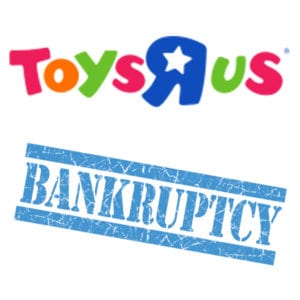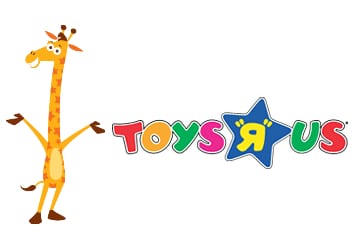 2017 has been a particularly bad year for many of the nation’s retailers. On September 19, Toys R Us announced its filing of Chapter 11 Bankruptcy. Chapter 11 Bankruptcy is a form of bankruptcy wherein a corporation (or an individual whose debt exceeds certain monetary thresholds) seeks the reorganization of its debt through the mechanism of bankruptcy, and usually the continuation of its operations.
2017 has been a particularly bad year for many of the nation’s retailers. On September 19, Toys R Us announced its filing of Chapter 11 Bankruptcy. Chapter 11 Bankruptcy is a form of bankruptcy wherein a corporation (or an individual whose debt exceeds certain monetary thresholds) seeks the reorganization of its debt through the mechanism of bankruptcy, and usually the continuation of its operations.
Toys R Us announced in a statement that it voluntarily sought Chapter 11 protection, “To achieve our financial objectives, Toys R Us and some of our US subsidiaries and our Canadian subsidiary proactively and voluntarily filed for Chapter 11 of the Bankruptcy Code in the US.” Toys R Us, based on Wayne, New Jersey, also stated that the Canadian subsidiary also instituted bankruptcy proceedings, but its Asian operations did not. Toys R Us declared:
“We are confident that this financial restructuring is the best path forward to ensure that Toys R Us can invest in our business, continue to improve our customer’s experience and strengthen our competitive position. We are confident that this financial restructuring is the best path forward to ensure Toys R Us can invest in our business, continue to improve our customer’s experience and strengthen our competitive position.”
Macys, JC Penny, Sears and Kmart have announced the closing of many of its stores. Sears Holdings on August 24 announced the closing of an additional 28 locations. JC Penny closed 138 stores in July, 2017. Macy’s announced in February the planned closing of 34 stores, in addition to the 70 locations it closed in 2016.
Vitamin World also filed Chapter 11 Bankruptcy, and plans the closing of at least 51 of its 334 stores. On September 6, Gap and Banana Republic revealed plans to close 200 locations. Concurrently, Gap plans to open 270 locations for its more popular Old Navy and Athleta offerings.
Perfumania filed Chapter 11 Bankruptcy in August, 2017, and the closing of 64 of its 226 stores. Teavana announced the closing of all of its locations. Gymboree also filed Chapter 11 Bankruptcy, and plans the closing of 350 stores. True Religion filed Chapter 11, and expects at least 27 stores to close. Many other retailers have either filed Chapter 11 Bankruptcy or are undertaking various efforts at restructuring. Ascena Retail Group, which owns Ann Taylor, Loft, Lane Bryant, Dress Barn, Justice, and others, plans the closing of 667 locations. The list continues with Michael Kors (100-125 stores), Payless ShoeSource (512 stores), Bebe Stores (180 locations), Rue21 (400 stores), Radio Shack (1,000 stores), Abercrombie & Finch (60 stores), Guess (60 stores), Crocs (160 stores), The Limited (250 stores), Wet Seal (171 stores), American Apparel (110 stores), HH Gregg (220 stores), GameStop (150 stores), Staples (70 stores), CVS (70 stores), and Family Christian with 240 closings.
Numerous explanations are given for these retailers’ financial struggles. Urban Outfitters Chief Executive Officer Richard Hayne attests, “There are just too many stores, especially those that sell clothing. This created a bubble, and like housing, that bubble has now burst. We are seeing the results. Doors shuttering and rents retreating. This trend will continue for the foreseeable future and may even accelerate.”
S&P Global explanation for its reduction of Neiman Marcus rating from CCC+ to B-, may explain some of the reasons for many of the ills experienced by such retailers. S&P stated that Neiman Marcus’ “Capital structure is unsustainable over the long term. Trends such as weak mall traffic, a highly promotional retail apparel environment and cautious consumer spending continues to weigh heavily on Neiman Marcus.”
There are many elements creating such retailers’ financial distress. One explanation not often cited, is the impact of private equity operations. The majority of the bankruptcy filings in 2017 come from retailers that were previously acquired by private equity firms. In the previous five years, approximately 31% of the bankruptcy filings were from companies previously acquired by private equity firms.
Such transactions are referred to as a leverage buyout. The private equity firm obtains majority control over the targeted company through a combination of equity and debt. After the private equity firm obtains control over the corporation, its saddles the targeted company with debt. The onerous debt applied to the company often strangles the ability of the company to ultimately continue its operations.
Private equity firms usually seek undervalued retailers. After the firm obtains control over the company, it invariably seeks to remove what it deems unnecessary costs. Labor costs are usually reduced through the termination of employees and the reduction of wages, and benefits. Real estate holdings may be sold. The private equity firm will charge the company or retailer enormous fees for its “services” in the restructuring of the company. The majority of the costs eliminated through the efforts of the private equity firm accrue to the benefit of the firm and its investors.
Toys R Us was in a period of long decline before the company was overtaken by a group of private equity firms, Kohlberg Kravis Roberts, Bain Capital Partners, and Vornado Realty Trust, in 2005. A number of commentators speculated that the motivation for the takeover was primarily to obtain control over the real estate owned by Toys R Us and its affiliate, Babies R Us, than about the business of toys and baby products.
The private equity team saddled Toys R Us with $7.5 billion dollars in debt. The above named private equity firms today still exercise control over the Toys R Us corporation. The company has somewhat reduced its debt, which stands at approximately $5 billion dollars today. The retailer faces a $400 million dollar payment on the interest on its debt in 2018. In 2019, an additional $1.7 billion dollars is due.
Dave Brandon became the CEO of Toys R Us in 2015. Brandon announced several strategies to rescue the struggling brand. His stated intent was to create a more exciting experience for its customers, including allowing the children to fly drones about its stores, pokemon card trading events, and more permissive testing of its products by the children who peruse its locations.
Despite such efforts, the company continued to decline. In 2016, Toys R Us sales diminished another 1.4% despite an increase in overall toy industry sales of 5%.
Toys R Us apparent beginnings were the story of a solitary man fueled by entrepreneurial zeal and inspiration. In 1957, Charles Lazarus opened the first Toys R Us after he established a furniture store named Children’s Bargain Town in his hometown in Washington. The 23 year old Lazarus opened Bargain Town below his father’s bike shop.
 The company’s logo and mascot, a giraffe named Geoffrey, appeared first in a 1973 television commercial for the toy store. The R in Toys R Us was written backward in order to create the appearance that a child wrote it.
The company’s logo and mascot, a giraffe named Geoffrey, appeared first in a 1973 television commercial for the toy store. The R in Toys R Us was written backward in order to create the appearance that a child wrote it.
Eric Clark wrote in “The Real Toy Story” that “Lazarus offered toy manufacturers the tantalizing picture of year-round toy sales and the ability to produce 12 months a year.” Lazarus was a strong negotiator. Instead of paying the toy manufacturers on deliver, he forced them to accept payments months later. He also required they invest in advertising to the benefit of Toys R Us.
Lazarus was one of the first corporate leaders to establish a computerized inventory system, wherein he could document every sold product, and arrange inventory accordingly.
Furthermore, Lazarus was amenable to change. He quickly embraced the advent of video games, which enticed both children and adults into his stores. Lazarus said, “There is an increasingly fine line between where adult begins and child ends.” Lazarus added, “We strongly believe that electronic games are not a fad; it is the way America is playing games now and will increasingly do in the future.” Even during the reign of Lazarus, Toys R Us began to experience financial difficulties, beginning in the 1990s. Mr. Lazarus retired in 1994, and observed the continual decline of his creation. Big box stores, such as Walmart and Target, were affecting the Toys R Us empire. The rise of Amazon was also destructive to Toys R Us’ financial standing. The private equity acquisition of Toys R Us, signaled its eventual destruction.
Other challenges face Toys R Us. Toys are no long a primary desire of many children and teenagers. Many are more consumed with smartphones, tablets and apps. Approximately 66% of teenagers own their own smartphone or tablet.
Many of the toys now offered in the Toys R Us stores are less than inspiring. Lego AS and other offerings seem to create little excitement for the children who peruse the aisles.
Toys R Us announced a number of strategies it will employ in its Chapter 11 filing. The corporation has agreed to $3 billion dollars in “debtor in possession” financing from a group of banks led by JP Morgan. This infusion of capital may allow the company to continue operations while it seeks the restructure of its $5 billion dollars in debt. Generally, such a creditor or creditor will take priority over most other creditors in a Chapter 11 bankruptcy. If Toys R Us is eventually liquidated, JP Morgan and its group of banks will likely be paid before most other creditors of the company.
Some of the suppliers may receive less than full payment. Mattel is owed $135 million dollars and Hasbro is owed $59 million dollars.
USA Today reported that Toys R Us plans to renegotiate its leases, convert some of its stores into side by side Toys R Us and Babies R Us offerings, and improve its recently reconfigured online store. The company also plans on refocusing its Babies R Us brand, focusing on items that are less likely to be offered through Amazon, such as cribs.
Dave Brandon in reference to the bankruptcy filing said, “The company’s overleveraged capital structure has constrained it from making necessary operational and capital expenditures, including investing in the revitalization of stores. As a result, the company has fallen behind some of its primary competitors on various fronts.”
Since KKR, Bain and Vornado took over Toys R Us, the three private equity firms have charged $183 million dollars in advisory fees to its owners. Forbes reported that the majority of these fees were paid.
Kirkland and Ellis is the primary law firm representing Toys R Us in its Chapter 11 filing. Kirkland attorneys, according to the same Forbes article charge up to $1,000 per hour for their services. The same law firm advised Bain Capital in its takeover of Toys R Us in 2005. Mr. Brandon estimates Toys R Us will incur $96.5 million dollars in fees just to obtain the debtor-in- possession financing.
Even before the Chapter 11 filing, 40% of Toys R Us vendors were demanding cash on delivery payment. Toys R Us has endured a long fall from its height, under the stewardship of Mr. Lazarus. “Chapter 11 was certainly not the company’s preferred outcome”, said Brandon.
Image credit: Toys”R”Us, aquir / 123RF Stock Photo

